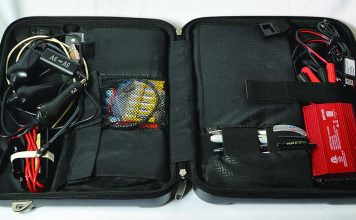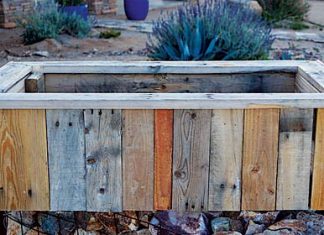 |
|
| Issue #145 • January/February, 2014 |

So here we are.
Truth be told, it was a complete accident that we found our farm. We weren’t even looking for it. We were really looking for a picnic spot under a trestle bridge the day we drove past the FOR SALE sign: “52 acres and house.”
I went to see the farm for the first time while my husband, Erik, was out of town at work. A few days later he was home and we walked the property together. We submitted our offer that afternoon, and closed escrow in August.
The farm
The house, finished in 1953, was occupied by Cyrus and Ruby and their children. The children grew up. Cy and Ruby grew old. They passed away within a year of each other, and not long after that, the property was put on the market. One of their daughters, Sandy, lives nearby and has been able to tell me a lot about the house, the property, and the area in general.
The land is bordered on one side by a river. A second river bisects the property, and a Portland and Western railroad track further divides it into quarters and makes three of the four parcels difficult to access. Around half of the property was used for hay and grazing for about 10 dairy cows. The rest is comprised of a woodlot, small pasture, barnyard, garden, and home.
Taking stock and taking notes
Maintenance on the farm and house had been largely deferred for the better part of two years, and as there was no other tenant, Mother Nature moved in. For the first two weeks we did nothing but clean house, haul bits of this and that to the landfill, and try to wrap our heads around the various tasks to be accomplished. Many things were apparent: the windows needed to be redone, there were problems with some of the wiring, and there was a long-term leak that had damaged the kitchen floor. Hundreds of other things we’ve discovered along the way. So many things made it onto our list, that even trying to prioritize the major items became tricky. We broke it down into broader categories: Sanitation, Safety, Winterizing. Anything that didn’t fit was shuffled to “Later.”
Sanitation
Sanitation was our first major concern. There were mouse droppings in the kitchen cupboards, in all of the closets, and all over the laundry room, attic bedroom, and basement. The solution for mice, of course, is a cat. Or, more precisely, a mama cat and kittens. The mice never had a chance. Our mama cat earned the name “Killer Kali” the first night, leaving half a dozen gifts on the front walk for us.
With the cats fully employed, we started cleaning. After a few days of that nonsense I called my friend Serai, who runs Inside-Out Cleaning Company in Oregon, to bring her dirt-fighting ninja team to help so Erik and I could work on closing up the basement and crawlspace accesses to keep even more mice from entering.
The walkout basement door had long since rotted off its hinges. Although it kept the worst of the wind and rain out of the basement, it did nothing to stop the entrance of spiders, mice, cats, people (the house had been burgled while on the market), or that uncomfortable, unsafe feeling that creeps up on you at two in the morning. There was nothing but bare concrete left, so Erik first framed in the walkout basement doors with pressure-treated lumber, using heavy duty construction adhesive to secure the framing to the cement door opening. He built a plywood door which locks with a cross beam. I’m sure we’ll redo the door again someday when Erik is ready to build his basement man cave. Not surprisingly, the house is warmer without a constant cold draft under the floorboards.
We bought good quality dust masks and a respirator (cheaper than a doctor’s visit just sayin’), along with an inexpensive shop vac motor that fits onto a 5-gallon bucket (about $25 at Home Depot) to suck up all the leftover mousie bits. A garden sprayer worked well for spraying down the basement with a diluted bleach solution.
Another issue we discovered was the presence of our neighborhood bug eaters bats, I mean, but yes, there were plenty of spiders, too residing comfortably in the attic bedroom. I like bats. Really, I do, but bats come with their own entourage of diseases, like rabies. (And most recently, bats in China have been found to carry the a virus like the one that causes SARS in humans). Since there is no door on the staircase to the attic, and the bottom of the staircase is in the bedroom where husband and I sleep, we just boarded up the stairwell. Sleeping whilst bats dine on the bedside lamp moths was just a bit much for me to deal with.
A pest control company did at least poke around to discover how they come and go, but unfortunately for us the solution entails tearing down the roof of the back patio so we can address the 30-foot-wide bat landing strip behind it. We’ll deal with the bats later.
Safety
Safety was addressed from two perspectives: injury prevention and home security. I am not so naive as to believe that a remote farm is immune to criminal intent, but I was surprised to hear that while the granddaughter of the previous owners lived here temporarily, her truck was broken into and the house was burglarized. That made me feel so safe that I went out and got a large dog. (His name is Cletus.) We also set up a spot against the hillside where I can keep in practice with my handgun and rifle skills. We later heard that a local ne’er-do-well was convicted of a spate of similar crimes.
The doors were all due to be replaced a lock failed and I had to kick one in myself our first night here so I didn’t bother buying new locksets. Instead, we replaced broken and missing locks on windows and installed barrel bolts on the exterior doors.
Exterior doors are notoriously difficult to install correctly, so Mike Lorenzen (“Build a pizza oven” in Sept/Oct 2013, Issue #143), talented retired builder and husband of our amazing real estate agent, Patty, installed one of the doors for me for a ridiculously low fee, earning my eternal gratitude.
Still on my “To Do” list: Installing the other two doors. They had to be custom ordered, so they weren’t ready when Mike was here, but we should be able to get to them in another week or so. I picked up stain and spar varnish to protect them from the elements.
Next, we addressed the various electrical shock and fire hazards. Take the electric dryer outlet, for example. A slow water leak and mouse infiltration had so compromised the integrity of the electrical box that by the time we pulled the particle board off the wall to have a look, the electrical box had rusted and broken, the outlet was completely corroded, and the wires were badly chewed by mice. The space between the studs had been a home to mice for many generations and was packed with dryer lint and cat food. Gross!
Unfortunately, we didn’t discover the extent of the damage until after our electric dryer shorted out, frying the motor. (Cha-ching!) I chipped away at the mouse nest (it was surprisingly resistant to attempts to remove it with a vacuum), replaced and grounded the outlet, and used spray-on electrical coating to cover up the mouse damage. We put up new wallboard temporarily, so when we have a licensed electrician out they’ll be able to easily inspect our work.
A few internal electrical issues that we thought might be wires shorting out turned out to just be old, worn-out switches. A funny thing we found is that nearly every light switch in the house was installed upside-down, meaning you have to flip the switch down to turn the light on. These can be reversed just by removing the faceplate, unscrewing the two screws that hold the switch in the electrical box, rotating the switch 180 degrees, then reinstalling.
When I replaced the porch lights I first had to pry mud out of the electrical boxes. Some sort of bug had been using them as a nursery, and there were perfectly shaped oval indentations in the packed, dried dirt where larvae had hatched. There was also quite a lot of rust inside the electrical box, so I added a bead of caulk around the new fixture to prevent any further water infiltration. (The fixture installation instructions say to leave a little space at the bottom uncaulked, so moisture can escape, but rain can’t get in.)
One obvious potential source of injury, especially for my curious three-year-old, was the several panes of cracked glass in the bedroom windows. I temporarily solved the issue by covering the cracks with packing tape. Classy, I know. Windows were on the “Winterizing list,” so I knew I’d be replacing the glass soon enough anyway.

Here’s our first fire of the season.
This insert can kick out the heat!
Winterizing
Ah, the windows. Cracked panes, moldy sashes, painted shut (or, my personal favorite, painted firmly in place and almost shut), and crumbling glazing putty. Windows were on the “To Do” list before we even moved in. At first we expected to completely replace them, but we decided that most could be rehabilitated.
I used a small pry bar to remove the interior casing and stop. (The stop is a ½ x 1-inch piece of trim that keeps the window in the frame.) There’s a second stop between the upper and lower sash that is a little harder to remove, since it fits into a groove in the window frame, but with a utility knife, pliers, and pry bar I was able to remove them without completely destroying them. Reglazing is messy and time consuming, mostly because of the drying time for the paint and the glazing compound, so I covered the window openings with clear trash bags while working on each window. The glass shop in town is much faster and more efficient than I am, and their prices are reasonable, so I’ll probably take the rest of the windows to them to complete.
We also built makeshift storm windows. They’re nothing fancy, just two layers of wooden lath strips, one wider than the other, glued together with simple lapped corner joints and reinforced at each corner with an “L” bracket. A piece of plexiglass fits into the channel formed by the narrower lath. I caulked around the edges of the plexiglass, added weather stripping around the edges, then screwed the storm window to the window frame. It works just fine. In fact, in our bedroom we only have a storm window up right now while I work on reglazing the window. We’ve noticed no difference in temperature from any other bedroom, and our nights are getting chilly.
The last major winterizing project was protecting our water line from freezing. There was plenty of evidence that the pipes had frozen in the past, and the line from the well to the house was so close to the surface that there was a possibility that the entire 75-foot run could freeze. Erik rented a mini-excavator and dug a new trench. Let me just say that if you ever have the opportunity to drive an excavator DO IT. It was so fun. We ended up using it for a bunch of stuff aside from the water system while we had it. We used polyflex pipe to replace the old water line and hooked into the existing fittings to the well and under the house, which ended up being a mistake. The old fittings all jostled loose just enough to spring 47 different leaks. We spent several days sleeping in town and working on plumbing during the day while we fixed the trouble spots. Since I’m about a foot shorter than my husband, I got to be the one under the house banging on pipes while Erik banged on them from outside. I can’t say it was fun, but we learned a lot about plumbing and did get all the leaks stopped.

Winter is here; there’s frost in the meadow and ice in the
water buckets, but the Soay sheep don’t seem to mind.
When we first moved in, we were warned that something might have died in the furnace ductwork. One of the ducts had been torn open to access plumbing behind it, then never repaired, so critters large and small had gained access. We hired a duct cleaning company to clear out the bodies, droppings, and general dirt, and even they were impressed with how much they removed. They use a massive, truck-mounted vacuum with about a 12-inch diameter vacuum hose, and the way it shook and shimmied as “stuff” came out was pretty remarkable. The ducts were repaired with screws and duct tape (yes, that really is what it’s for), then we fired up the furnace. Money well spent.
The chimney also needed to be cleaned out. I’m glad we didn’t light a fire before taking care of this, because we probably would have had a chimney fire. (There are soot marks on the outside of the chimney about half way up, indicating a minor chimney fire in the past.)
Although our list of things to do keeps growing, at least we can check a few of these major things off so we can enjoy the rest of winter without any major system emergencies. The roof doesn’t leak, the propane tank is full, the firewood is in, and the pantry is stocked. What else could I ask for?
Now that the weather has turned cold, we’ll be focusing on fixing up the inside of the house, and there will be plenty of time to plan future improvements. This morning it is 28 degrees, so we’re enjoying our coffee by the blazing fire. As we watch the sun rise over the frosty meadow, I know I’m finally home here on Everfree Farm.






















